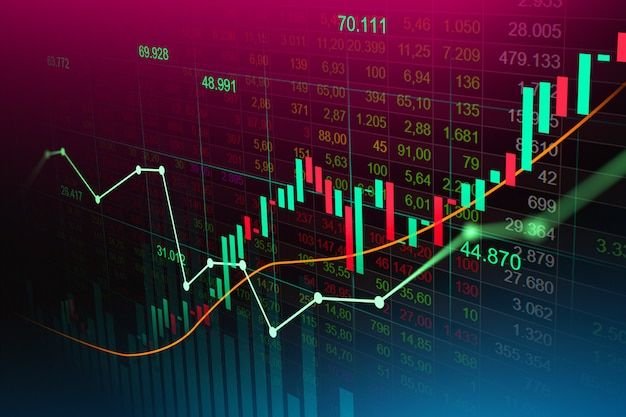The stock market fell on Tuesday, as escalating tensions in the Middle East weighed on investor sentiment. After a strong quarter and positive monthly gains for major indices, the sudden geopolitical flare-up has raised fresh concerns. As a result, all three major indices slipped, with the tech-heavy Nasdaq bearing the brunt of the losses.
The Dow Jones Industrial Average dropped 71 points, or 0.2%, while the broader S&P 500 declined 0.7%. The Nasdaq Composite, which is more sensitive to changes in technology stocks, fell a steep 1.3%. Energy stocks were the exception, as they rallied in response to the surge in oil prices.
Middle East Tensions Shake Markets
Tuesday’s losses were primarily driven by geopolitical developments. Reports surfaced that Iran had fired missiles at Israel, causing West Texas Intermediate crude oil to spike. The news rattled the markets, as investors scrambled to gauge the potential impact of a broader conflict in the Middle East. This uncertainty led to a notable jump in the CBOE Volatility Index (VIX), which is often referred to as Wall Street’s fear gauge. The VIX rose above 20, signaling increased anxiety among traders.
Historically, rising geopolitical tensions tend to drive investors towards safer assets such as gold, bonds, and energy stocks. The latest Middle East developments appear to have triggered this exact pattern. As the news broke, oil prices surged, boosting the energy sector. The S&P 500’s energy sub-sector climbed nearly 2% as investors bet on the potential for higher energy costs and supply disruptions.
Broad Market Declines Amid Rising Volatility
Nearly 60% of S&P 500 stocks traded lower during Tuesday’s session, reflecting widespread concern across the market. The losses were not confined to a particular sector, though technology stocks suffered disproportionately. This broad-based decline hints at growing investor wariness, not just about geopolitical issues but also economic uncertainties closer to home.
Tech stocks like Tesla, Nvidia, and Apple fell sharply, each dropping more than 3%. These companies are heavily influenced by investor sentiment and are often the first to experience outflows during periods of heightened risk aversion. However, Facebook parent company Meta bucked the trend, gaining ground and nearing its all-time highs.
The overall decline in the market suggests that investors are still cautious, even after a strong showing in the previous quarter. Despite closing out the month and quarter with gains, the recent uptick in volatility is a reminder that the market remains vulnerable to external shocks.
Energy Sector Rises on Oil Price Surge
While most sectors struggled, energy stocks provided a bright spot. The sector was the day’s best performer, gaining nearly 2% as oil prices jumped. West Texas Intermediate crude oil surged to multi-week highs following the news of Iran’s missile attacks. Traders flocked to energy names, betting that potential supply disruptions would support higher prices.
This reaction underscores the sensitivity of energy markets to geopolitical events. Even a temporary supply disruption in the Middle East can have far-reaching effects, as the region remains a critical supplier of crude oil to the world. For energy companies, higher oil prices translate directly into improved revenues, which explains the sharp divergence of energy stocks from the broader market downturn.
ExxonMobil, Chevron, and Halliburton were among the notable gainers. As long as uncertainty remains in the Middle East, energy stocks are likely to continue to outperform other sectors, making them an attractive option for investors seeking a hedge against geopolitical risk.
Tech Sector Under Pressure
The technology sector bore the brunt of Tuesday’s sell-off. The outsized losses in tech names dragged down the Nasdaq Composite more than the other indices. Companies like Tesla, Nvidia, and Apple all saw declines exceeding 3%. This sharp drop can be attributed to several factors.
Firstly, technology companies are highly sensitive to investor sentiment. When concerns about global stability arise, traders often rotate out of high-growth, high-risk tech names and into more stable sectors like utilities or consumer staples. Secondly, the prospect of higher interest rates has weighed heavily on tech stocks. Higher rates reduce the present value of future earnings, which disproportionately affects high-growth sectors like technology.
Even within the tech sector, however, not all companies were affected equally. Meta (formerly Facebook) rose during the session, reflecting investor confidence in its long-term strategy and recent business performance. The company’s stock is nearing all-time highs, driven by positive earnings reports and a robust growth outlook.
Small-Cap Stocks Feel the Heat
Small-cap stocks, as represented by the Russell 2000 index, also struggled on Tuesday, falling more than 1%. Small-cap companies are particularly vulnerable during periods of uncertainty. They generally have less diversified revenue streams and are more sensitive to economic disruptions than their larger counterparts.
The decline in small-cap stocks suggests that investor confidence in the broader economic outlook remains fragile. With ongoing concerns about inflation, interest rates, and global supply chain disruptions, small-cap companies may face a more challenging environment in the months ahead.
September Defies Expectations
Interestingly, Tuesday’s decline comes just after a surprisingly strong September. Historically, September has been one of the worst months for stocks. Yet, this year, the S&P 500, Dow, and Nasdaq all posted gains, marking the first positive September for the S&P 500 since 2019.
The strong monthly and quarterly performance can be attributed to a combination of factors, including robust corporate earnings and investor optimism around the Federal Reserve’s interest rate policy. However, the current pullback suggests that traders are reassessing their outlook in light of the latest geopolitical and economic developments.
Fed Chair’s Remarks and Market Outlook
Part of the market’s uncertainty also stems from comments made by Federal Reserve Chair Jerome Powell. Speaking earlier this week, Powell stated that the central bank is “not on any preset course” regarding its next moves on interest rates. He hinted at two more rate cuts this year — each likely a quarter of a percentage point — if the economy continues to perform as expected.
Investors have been closely watching the Fed’s actions, as interest rate policy has a significant impact on equity valuations. The market had rallied on expectations that the Fed would remain accommodative. But Powell’s comments, suggesting flexibility rather than a firm commitment, have introduced a new layer of uncertainty.
Looking ahead, investors will be paying close attention to the upcoming nonfarm payrolls report for September, due on Friday. The employment data will serve as a key indicator for the Fed’s next moves. A strong report could solidify expectations for further rate cuts, while a weaker report might push the central bank to hold off.
Labor Strike Adds to Economic Concerns
Adding to the uncertainty is the ongoing strike by members of the International Longshoremen’s Association on the East and Gulf coasts. While the strike’s impact may not be immediately felt by consumers, it has the potential to cause significant economic disruptions if it continues.
A prolonged stoppage could impede the flow of goods into and out of the United States, affecting supply chains and potentially leading to higher prices for consumers. This would add to the inflationary pressures that the Fed is already grappling with.
Analysts estimate that the strike could cost the U.S. economy hundreds of millions of dollars. If not resolved soon, the strike could weigh on economic growth in the fourth quarter, further complicating the Fed’s decision-making process.
Investor Sentiment: What’s Next?
As traders digest the latest news, the broader question remains: What’s next for the markets? The recent pullback suggests that the market’s mood is shifting from optimism to caution. The spike in the VIX indicates rising fear and uncertainty among investors. While the strong quarter and positive September performance were encouraging, they might not be indicative of what’s to come.
The Middle East conflict is far from resolved, and its impact on energy prices and global stability remains a wild card. Coupled with uncertainty around Fed policy and the labor strike, the market faces a host of challenges in the near term.
For investors, the current environment calls for a more cautious approach. Diversifying portfolios, focusing on quality companies with strong balance sheets, and keeping an eye on developments in the energy sector could be prudent strategies. As always, staying informed and being prepared to adapt to changing conditions will be key to navigating the turbulent waters ahead.
Final Thoughts
Tuesday’s market decline serves as a stark reminder of the fragility of investor sentiment. Despite a strong quarter and positive monthly gains, the sudden spike in geopolitical tensions and growing economic uncertainty have quickly reversed the market’s upward momentum.
With the VIX rising and tech stocks stumbling, it’s clear that investors are adopting a more cautious stance. The energy sector’s outperformance highlights the growing focus on defensive plays amid uncertainty. As we move into the final months of the year, all eyes will be on the Middle East, the Fed’s next moves, and the broader economic outlook.
For now, traders should brace for more volatility and be prepared for the unexpected. In a market defined by uncertainty, flexibility and vigilance will be essential traits for any investor looking to navigate the challenges ahead.
ALSO READ: Indian Stock Analysis: Saregama, National Aluminium, More




